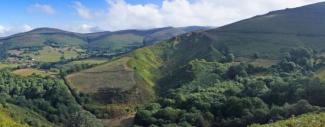Social Structure and Territory. Landscape Archaeology (EST-AP)

Researcher in charge: Inés Sastre Prats
Members:
- Brais Xose Currás Refojos
- Pilar Diarte Blasco
- Isabel Fernández Urbina
- Alicia Hernández Tórtoles
- Almudena Orejas Saco del Valle
- Francisco Javier Sánchez-Palencia Ramos
The research group focuses on cultural landscapes as the basis for understanding social formations in Ancient Hispania ––specially the Northwest––, including the transition from the Iron Age to Roman domination. The methodological approach is through Landscape Archaeology, which enables an integral analysis of all types of information, including archaeological, written and iconographic data. Of special interest is the rural territory, in which Rome often carried out intensive mining activity. One of the main activities carried out by the group includes the transference of research in the form of the creation and management of lasting cultural heritage resources for local communities. This has resulted in the successful valorisation of the Las Médulas Archaeological Zone (León; UNESCO World Heritage Site since 1997), and Pino del Oro (Zamora) and Las Cavenes del Cabaco (Salamanca) Mining Zones.
The main objective is the study on the transition from the pre-Roman world to the Early Empire, based on the analysis of landscapes, predominantly from the western Iberian Peninsula.
Given the current situation of budgetary cuts in R+D investment on all levels, the research group will focus on studies which are already in place, for which the use of carry-over funds from previous years is absolutely necessary. The main threat for our research's continuity is the diminishment of resources provided for the R+D Laboratories' activity and the employment of highly-qualified support personnel.
Specific objectives:
- The study of the castro communities (7th-2nd cents. BC) as segmentary agrarian societies (Bierzo, western Zamora, Rías Baixas).
- The study of Roman provincial society in Hispania, and the implementation of the civitas system, including local diversity (western Zamora, Eastern Portugal, Bierzo, western Asturias), enlarging the scope to the 2nd and 3rd centuries.
- Study of the impact of mining activity in the transformations metioned: a study of Roman republican mining zones from Northern Italy (Bessa) as a precursor of Hispanic mining; archaeomining analysis to determine chronological indicators, as well as the environmental impact in the study areas.
- Application of methodologies and analytical techniques which may be disseminated and generate innovative resources through strategies of heritage management within territorial planning, regulating and exploitation.
-----------------------------------------------
Dept. of Archaeology and Social Processes
Research Groups


